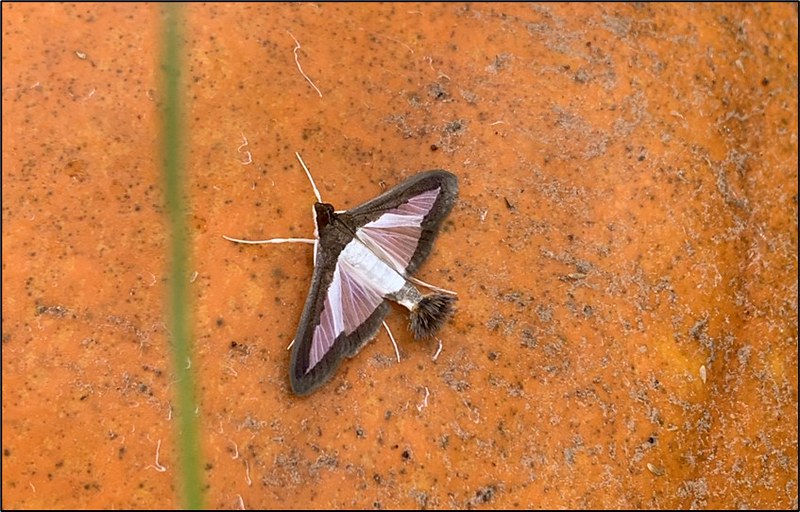By Sarah Cato
U of A System Division of Agriculture
With fall approaching, Arkansas pumpkin growers are nearing harvest. But while fruit ripens on the vines, growers should be on the lookout for melonworm.
Melonworm is a pest of cucurbit crops — a family that includes cucumbers and watermelons — that feeds on plant foliage and fruit, usually etching pumpkin rinds just under the stems or where the fruit contacts the ground. Often confused with pickleworm, melonworm is a different, tropical species that migrates to Arkansas from coastal regions. Because melonworm doesn’t overwinter in Arkansas, its arrival varies year to year, typically beginning in early to mid-September, but sometimes as early as late August.
Melonworm moths have white, almost translucent, wings with a brown outline. Larvae are green caterpillars with two longitudinal, white stripes down their back and 4 sets of prolegs.
“When we see melonworm really depends on the climatic conditions for the year,” said Aaron Cato, horticulture integrated pest management specialist for the University of Arkansas System Division of Agriculture. “In 2021, moths showed up in late August, much earlier than previous years and began multiplying rapidly before pumpkin harvest started.”
Significant damage
This early arrival led to significant damage in pumpkins statewide in 2021.
“By late September, we were seeing a large number of damaged pumpkins and a lot of growers saw a 50 percent yield loss or more by the end of the year,” Cato said. “Melonworm was by far our biggest pumpkin pest in 2021.”
Cato said melonworm larvae will quickly defoliate leaves of pumpkin plants, feed on the rind and burrow under the handle, causing the stem to pull off when grabbed. Feeding on the rind results in the fruit ultimately becoming unmarketable. However, there are warning signs to look out for and treatment options available.
“Seeing moths in the field should be an early sign for growers that an insecticide application may be necessary,” Cato said. “If growers can easily find the white and brown moths flying in plantings, or if they’re seeing larvae on leaves, a pesticide application will be necessary.”
Many effective products for melonworm are available. Although an economic threshold for this pest doesn’t currently exist, research in Arkansas is ongoing.
“Our data from 2021 and 2022 indicates that pesticides containing chlorantraniliprole, such as Coragen or Shenzi, do the best job because they have a long residual,” Cato said. “Pyrethroids like bifenthrin or lambda-cyhalothrin only achieved moderate levels of control and likely aren’t going to get the job done.”
Mention of product names does not imply endorsement by the University of Arkansas System Division of Agriculture.
To learn about extension programs in Arkansas, contact your local Cooperative Extension Service agent or visit www.uaex.uada.edu. Follow us on Twitter and Instagram at @AR_Extension. To learn more about Division of Agriculture research, visit the Arkansas Agricultural Experiment Station website: https://aaes.uada.edu/. Follow on Twitter at @ArkAgResearch. To learn more about the Division of Agriculture, visit https://uada.edu/. Follow us on Twitter at @AgInArk.






